Electric Freight Locomotives of India: The WAG Series

Before there was the celebrated WAP series, there were the WAGs. No, not the WAG as in football terminology, but Broad Gauge (W) AC Electric (A) Goods/freight locomotives (G) of the Indian Railways, which railfans consider to be much more eye candy than the WAPs (well, in most cases). The WAGs are serious business. They may not be glamorous or make a lot of noise, but they are the powers behind the throne, the actual unsung heroes of India that silently work away behind the scenes, driving the economy of the country, moving all imaginable freight and the occasional passenger across the country. The WAGs are everywhere, toiling away silently, all but invisible to most people, but if you start looking for them, you will start seeing only them! The WAG series was first developed in 1963 to service the newly electrified Kolkata region and then spread across the country along with electrification. It has the most number of locomotive series within it with the WAG12 being the latest in that line.
The WAGs are all about power. Raw, brutal power and torque. Speed is not as essential for goods locomotives as hauling power is, hence they trade speed for power and torque to haul the heaviest of loads weighing hundreds of times more than the average passenger train. The biggest challenge for them is to start off from standstill and to tackle gradients for which they have to be heavier and possess high starting tractive effort, adhesion factor (grip) axle-mounted traction motors etc., all engineered to provide maximum pulling power, as we will see in this chapter. So here is all about the history, evolution and specifications of all of India’s electric freight (goods) locomotives! If you would like to have a quick overview on how electric locomotives work, click here.
Click the class type below to jump directly to its particular section:
WAG1 | WAG2 | WAG3 | WAG4 | WAG5 | WAG6 | WAG7 | WAG8 | WAG9 | WAG10 | WAG12
WAG 1
- India’s very first electric goods locomotives
- Built in Europe along with WAM1
- Production Period: 1963-1966
- Total Produced: 112
- Preserved: 01
- Wheel Arrangement: B-B
- Top Rated Power: 2900 hp
- Top Speed: 80 kph
- Weight: 85t; Tractive Effort: 30t; Axle Load: 21.3t
The WAG1 was India’s first dedicated Goods locomotive. The 50Hz Group/European Group/50 Cycles Group (consortium) delivered the WAG1 along with the WAM1 as per their contract with the Indian Railways. The WAG1 though came from the same manufacturer was not a modified version of the WAM1. It was completely different and specifically built for cargo operations. All that they shared with the WAM1 was the SNCF design philosophy with its boxy “breadbox” shape, plain sidewalls with round portholes and long windows on the driving cabs that would be followed down the line for all Indian electric locomotives until the WAM4/WAG7.
The WAG1 was considered a failure as it was underpowered just like the WAM1. It weighed only 20 tons and could only haul 1820 tonnes of cargo. Today we know that the major shortcoming of the locomotive lay in its monomotor B-B bogies (one traction motor per two axle bogie) which delivered only eight wheels and two traction motors per locomotive. This is strange since the WAM1 which was designed along with it had 4 traction motors! This was a favourite French design of the time because of its technical efficiency, predictability, proven performance, light weight, high adhesion and speed. It also featured some very advanced features for the time like regenerative braking, air brakes and multiple unit operation for up to 4 units. However, none of that mattered because they couldn’t do what they were supposed to do. The French probably didn’t give much thought into the fact that these locomotives had to operate on Broad Gauge which itself meant that the amount of weight they would need to pull was manifold of the European Standard Gauge.
42 WAG1s were imported from France and more than 60 were built in India at CLW, the first one #20710 “Bidhaan” rolling out in November 1963. It was the very first AC electric locomotive of any type built in India and was homed at Vijayawada BZA/SER. They were in service until 2000 when all were scrapped but Bidhaan which is preserved at the National Rail Museum, New Delhi.
Drive: Two Alstom MG1420 DC traction motors, fully suspended, connected to wheels by Jacquemin drives, controlled by tap-changers and silicon-controlled rectifiers.
WAG 2
- Japanese version of the WAG1
- All imported fully built
- Period of Production: 1964-65
- Number Produced: 45
- Preserved: 0
- Top Rated Power: 3180 hp
- Top Rated Speed: 80 kph
- Wheel Arrangement: B-B
- Weight: 86t; Tractive Effort: 30t; Axle Load: 21.3t
The WAG2 class, just like the WAM2, was supplied by the Japanese Hitachi-Toshiba-Mitsubishi consortium as an alternative to the WAG1. These locos were smaller than the WAG1, probably the smallest locos in India ever. All design aspects were similar to those of the WAG1 but were identifiable by larger cab windows, banks of larger ventilation panels on their sides and were overall more “compact” and “cuter” than the muscular WAG1. What they shared with the WAG1 was its shortcomings. They featured the same monomotor B-B bogies of the WAG1 but with Hitachi traction motors connected to the wheels by a Quill drive instead of the WAP1’s Jacqemin drive. This resulted in increase in 360hp in power from the WAG2 compared to its predecessor. The WAG2 was technologically superior to the WAG1 though, featuring silicon diode rectifiers instead of Exitrons and control through tap-changers.
The Japanese supplied 45 locos which were all homed at Asansol ASN/ER. Asansol seemed to act as the receiving station for all new AC loco types those days. They are all scrapped now. Here you can see WAG2 #20811 under construction in a Japanese factory.
Drive: Two Hitachi EFCO DC traction motors, fully suspended, connected to the wheels by a geared drive, controlled by tap-changers and silicon-diode rectifiers.
WAG 3
- Procured from the European Group
- The same WAG1 with different Traction Motors
- Production Period: 1965
- Number Produced: 10
- Preserved: 0
- Top Rated Power: 3150 hp
- Top Rated Speed: 80 kph
- Wheel Arrangement: B-B
- Weight: 87t; Tractive Effort: 30t; Axle Load: 20t
The WAG3 was procured from the 50Hz Consortium of Europe while deliveries of the WAG1 were still underway. It was the result of Indian Railways probably demanding more power. The WAG3 was nearly the same WAG1 locos with their B-B monomotor bogies and all but with a different set of traction motors and featuring the more advanced Silicon diode rectifiers. The more important difference was that the traction motors for the WAG3 were two units of Alstom MG1580A1 which helped the WAG3 output 250 hp more top power than the WAG1. The traction motoers were still mounted on the bogies and connected to the wheels via a drive, though. With these changes, the WAG3 would provide the template based on which Indian freight locomotives would be built for the next three decades.
With the WAG3, we had acquired three different classes of locomotives together totaling 167 in number in a time span of 3-4 years. Only the shell of the locomotive was built by Henschel and not the entire loco as is wrongly attributed at many places. Ten units were imported and were all used on the Eastern Railway. All WAG3s are of course scrapped today.
Drive: Two Alstom MG1580A1 DC traction motors, fully suspended, connected to the wheels by a Quill drive, controlled by a tap-changer and silicon-controlled rectifiers and “field weakening”.
WAG 4
- New loco based on the WAG3
- Assembled in India at CLW
- Production Period: 1966-1971
- Number Produced: 186
- Preserved: 01
- Top Power Rating: 3150 hp
- Top Rated Speed: 80 kph
- Wheel Arrangement: B-B
- Weight: 87t; Tractive Effort: 30t; Axle Load: 20t
The WAG4 was a “Make in India” attempt to create a better locomotive using the earlier three WAGs as concepts. It attempted to combine the best parts of the three. Most of it was still the WAG3, as IR found it to be the best performing among the three Goods locomotives even though it was quite lacking in the power department. It still had the monomotor B-B bogies but also featured the more advanced Rheostat braking, silicon rectifiers and tap-changer control. The real discovery here was the Alstom MG1580A1 traction motors though. CLW had by that time acquired manufacturing rights for them through a transfer of technology agreement and started manufacturing them in India. The WAG4 became only the second electric locomotive to be manufactured in India after the WAM1. The first units were technically still assembled in India from components were still supplied by the 50Hz Group.
CLW built 186 of them in just 5 years but abruptly stopped their production in 1971 when the WAM4 was introduced and changed everything. WAG4D stood for “Dual Brakes”. They are all scrapped now.
Drive: Two Alstom MG1580A1 DC traction motors on two 2-axle monomotor bogies, fully suspended, connected to the wheels by a Quill drive, controlled by a tap-changer and “field weakening”.
WAG 5
- Modified version of the WAM4 created by CLW
- No relation to any of the previous WAGs
- Production Period: 1978-1998
- Number Produced: 1194
- In Service (July 2022): 988
- Wheel Arrangement: Co-Co
- Top Power Output: 4390 hp
- Top Speed: 100 kph
- Weight: 119t; Tractive Effort: 33.5t; Axle Load: 20t
In 1970 the WAM4 debuted, and the Indian locomotive scene was never the same again. It perfectly met the requirement of all electric locomotives of the Indian Railways (remember, the electrified route length back then was minuscule). The production of the WAG4 was halted as it was no match to the WAM4. They probably thought there wouldn’t be a need of a dedicated freight locomotive anymore, and hence there were no dedicated electric goods locomotives built in India in the 7 years from 1971 to 1978.
However, as they say, things always change. The mid 1970s brought with it an unprecendented energy crisis, which led the Indian Government, like many across the world to rethink its reliance on imported energy sources to run their economies. In 1979 a decision was taken to set an ambitious target to electrify all trunk routes in the country within the next 25 years (total electrified route kilometers would double from 1980 to 1990). This new focus on electrification led to an astonishing reversal of fortunes. The dead WAG class was bought back to life and the roaring WAM class was put on the chopping block as it was suddenly not adequate enough for IR’s future. A dedicated passenger locomotive class (WAP) was decided to be developed instead.
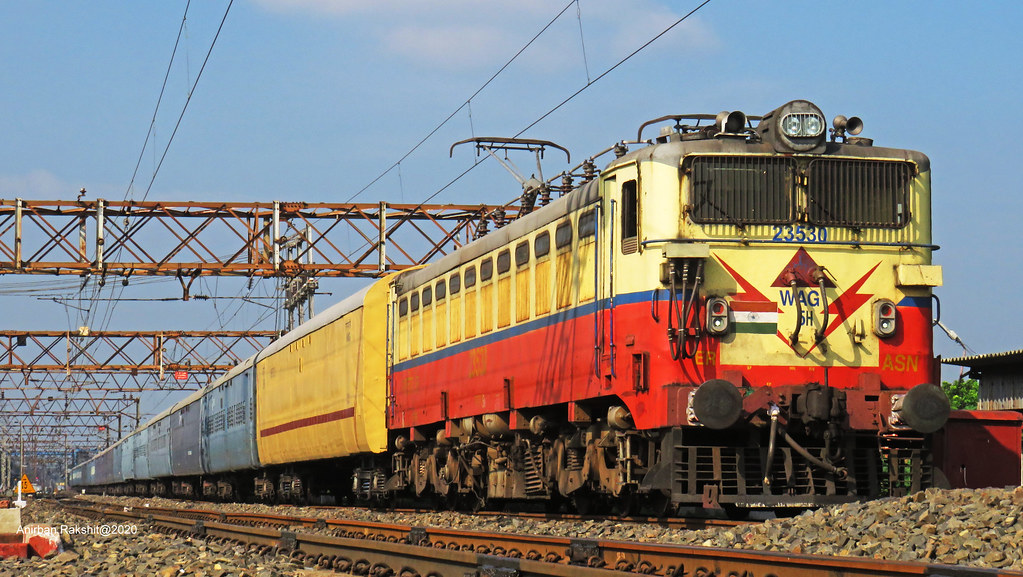
A new dedicated freight loco would of course come from the WAM4. The WAM4B was created in 1978 itself someone at CLW/RDSO modified (re-geared) the WAM4 to specifically haul freights. The WAG5 class was born! Yes, despite its name the WAG5 had nothing to do with any of the previous WAG classes. It was only a re-geared, modified and more powerful version of the biggest electric success story of the Indian Railways until then. The WAG5 featured all that made the WAM4 great, especially those classic ALCO six-axle asymmetric trimount bogies, silicon diode rectifiers and one-per axle-mounted Alstom TAO659 traction motors that CLW was manufacturing under technology transfer agreement. Later, CLW started using another traction motor design from Hitachi, the HS15250, also manufactured in India under ToT. Even later, IR adopted the roller suspension of the Hitachi TMs for for some Alstom TAO TMs, and the WAG5s using this arrangement came to be known as WAG5 TAOCHI in a very zen-like sounding manner. BHEL too turned out some WAG5s.
WAG5s come in a bewildering array of subtypes (just like the WAM4) with letters denoting everything from traction motor type to rheostatic braking. The most common variants are WAG5A for those with Alstom motors, WAG5H for Hitachi motors, WAG5HA for WAG5s fitted with high adhesion bogies, WAG5P denoting passenger duties. However, but these letters are not part of any official classification but rather used as identification markers by individual workshops. Hence not all WAG5s with Alstom motors might be marked WAG5A and so on. The first WAG5 21103 was a converted WAM4B turned out in December 1978. The first “built as” WAG5 was #21139 and #23000 the first WAG5 to be built to its set specifications. A massive 1194 were built over two decades. The last WAG5 was #24074 turned out by BHEL on 1998.
Earlier WAG5s looked exactly like the WAM4 with circular windows on the side. Later ones have sides that look exactly like the WAP4 with ventilation grilles arranged in a row. Their standard livery was chocolate brown with a narrow yellow band running around them, but sheds were allowed to paint them in any scheme they wanted, which resulted in a colorful array of WAG5s. The most famous among them is the blue-silver-red “Barbie Doll” livery. Like its inspiration, the WAG5 changed Indian Railways in many ways and became its most successful locomotive class until then, eclipsing even the WAM4s.
Drive: Six Alstom TAO 659 or Hitachi HS15250A DC traction motors on two six-axle ALCO trimount bogies, axle hung, controlled by a tap-changer and “field weakening”.
WAG 6
- High power heavy haul prototypes
- Manufacturer: ASEA, Sweden
- Three classes: A, B, C, all imported
- Production Period: 1988
- Number Produced: 18 (6 each)
- In Service: 0
- Top Rated Power: 6110 hp
- Top Speed: 100 kph
- WA: Bo-Bo-Bo (6A, 6B), Co-Co (6C)
- Weight: 123t, Tractive Effort; 45t, Axle Load: ??
The WAG6 is another (short) story of a very capable locomotive not used to its maximum potential, especially the WAG6A variant. Most people, even railfans, do not even know of the existence of this unique, extremely powerful, technologically advanced (for its time) and fantastic-looking locomotive class. These rare specimens were sadly confined to services on only one line, the famous Kirandul-Kottavasala (K-K) line of the Waltair (Visakhapatnam) division of East Coast Railway. They were the most powerful locomotives until the arrival of the WAG9 and were only 200 hp less in their output compared to them, capable of hauling full freight loads at 100 kph! However, unlike how it might seem, the WAG6s weren’t bought in specifically for service on the K-K line, but were another milestone in IR’s quest for the perfect Indian electric freight locomotive.
By the mid 1980s, it was becoming clear that even the celebrated WAG5s were proving to be incapable of meeting India’s heavy freight hauling needs, especially of iron ore and coal. In 1987, IR invited multiple tenders for prototype high-powered freight locomotives. We had learned from our experiences with the earlier WAMs and WAGs and it was deemed that it was better to test locos in Indian conditions first before ordering them in bulk. They received six prototypes each of three types. First arrived the WAG6A from ASEA of Sweden, which would become ABB the following year. Their most defining feature was their unique Bo-Bo-Bo wheel arrangement (three two-axle bogies, all axles powered by individual motors), quite the novelty, as no Indian locomotive had ever had more than two bogies. With their large, disjointed vertical trapezoidal windows, pairs of individual headlamps and long corrugated sides, they were a huge departure from the seen-and-tired SCNF design philosophy. Next up were the WAG6B and the WAG6C from the Sumitomo corporation (Hitachi), the former also featuring a Bo-Bo-Bo wheel alignment and the latter Co-Co, but identical to the old WAGs in almost everything else. A unique feature of the WAG6 class was the presence of vestibule doors on the cabs of the locomotives, so when two were connected in multiple unit operation you could step between locos without getting off.
IR accepted all three types but decided to go ahead with none. Maybe because problems with the WAG5 was sorted out by then, or maybe because modern technologies like GTO Thyristor and IGBT were catching up. The WAG6s were all given to Visakhapatnam ELS and were put to service on the iron ore belt. With their 123 tonne weight, starting tractive effort of 45 tonnes and 6110 hp power, all almost equivalent to the WAG9 (123/47/6350), made them capable of just about anything. The WAG6As were supposedly even upgradable to 160 kph top speed thanks to their fully suspended traction motors, but this was never explored. We could’ve had a fleet of world-class class freight locos as powerful as the WAG7 and as fast as the WAP5, a whole decade before either entered service, but instead they were wasted away running up and down a 200-km stretch hauling BOXNs and BCNAs. They could’ve changed the face of the Indian economy if they were to be mass produced along with the WAG7.
Since they were prototypes, ABB and Hitachi didn’t make spare parts for them and they started breaking down for want of spares. The engineers at VSKP, India’s largest electric loco shed tried their best but still couldn’t keep the locos running, forcing them to cannibalize broken down locos for parts for the working ones. Even then they served well for 30 years. As of today (2022), all WAG6 class locomotives are retired from service and most have been scrapped. Only WAG6A #26000, WAG6B #26014 and #26015, and WAG6C #26020, #26022, #26023, #26025 survive today and most are on the block. Happily, WAG6A #26000 and WAG6C #26020 are earmarked for preservation. They are all reportedly parked around Visakhapatnam.
Drives: WAG6A: Six ASEA L3M450-2 DC traction motors on three 2-axle bogies, fully suspended, connected to the wheels by a geared drive. WAG6B: Six Hitachi HS15555OIR DC traction motors on three 2-axle bogies, bogie mounted, connected to the wheels by a geared drive. WAG6C: Six Hitachi HS15256UIR DC traction motors axle-mounted connected by a WN drive. All three drives were controlled by Thyristors and microprocessors.
WAG 7
- The most successful locomotive class in India
- Produced by CLW and BHEL
- Production Period: 1992-2015
- Number Produced: 1970
- In Service (July 2022): 1959
- Top Rated Power: 5000 hp
- Top Rated Speed: 100 kph
- Wheel Arrangement: Co-Co
- Weight: 123t, Tractive Effort: 41.5t, Axle Load: 20.8t
If the WAG5 was the superhit, the WAG7 was the blockbuster. It was with the WAG7 that the Indian Railways finally got its electric goods locomotive formula right. The locomotive that was India’s silent engine of economical growth in its greatest years. The first WAG7 took birth in 1992 at precisely the time the Indian economy started its roaring growth, and powered the country on its journey for the next 23 years, silently working and toiling in the background, hauling coal, cement, steel, timber, grains, containers, petroleum and even express and passenger trains. The success story of the WAG7 is a great example of “try, try, try and you will succeed”.
The WAG7 was of course a modified version of the WAG5. The WAG7 featured most of the same electricals as that of the WAG5, except for the 5400 kVA transformer which was of the same specs as that of the WAP4. Like how a child surpasses their parents’ achievements and how the WAG5 had surpassed the WAM4, the WAG7 trumped the WAG5 to become the most successful loco class in India. This was mainly the result of IR/RDSO/CLW finally getting the equation and balance between power and adhesion factor right. They developed brand new hi-tech fabricated (ALCO) high-adhesion bogies for the WAG7, giving it a lot of tractive effort (factor: 34.5%) at the cost of some speed. A tweaked version of the Hitachi HS15250 traction motors delivered the WAG7 14% more power and thereby enabled it to haul 21% more tonnage (2375t vs 3010t) than the WAG5.
CLW initially used the same old hand-me-down 1960s WAM1-inspired WAG5 shell for the WAG7 too, and all WAP7s were painted in a uniform livery of blue with a yellow band around their middle. Until then all sheds could paint their locos in any color scheme. Maybe this was to differentiate WAG7s from the SNCF types or maybe it was the result of the IR’s “uniformity” policy, where some imagination-challenged bureaucrat decided that all trains must look the same and started mass-painting everything blue. So WAG7s only ended up looking blue WAG5s. Then in 2007 someone had the brainwave of putting WAG7s in WAP4 shells for better aerodynamics. And so, 15 years and 894 WAP7s later, #27895 became the first WAG7 in a WAP4 shell. Now WAP7s looked like blue WAP4s which were orange, though it would be another 200 more locos before the WAP4 shell would become the standard for the WAG7. Two years later, BHEL also began building WAP7s to keep up with the demand, and painted them in a red-white-blue livery with a faceplate of alternating angular white and red bands. The WAG7s sporting this livery are called ‘Tigerface’. BHEL produced 199 WAG7s (#24501 to #24700), all Tigerfaces in WAP4 shells. The Tigerfaces seen in WAG5 shells are CLW-made WAG7s repainted in Tigerface livery.
Fun fact: Blue and Orange are complimentary (opposite) colors on the color spectrum, they cancel each other out. This makes sense, since the WAP4 and WAG7 are the antithesis to each other and sport almost the same configurations but are used for opposite purposes, making them the evil twins!
The first 71 WAG7s produced were all sent to the Mughalsarai shed of ECR, the heart of the coal belt. A whopping 1970 WAG7s were produced in 23 years, making them not just a runaway success but a flyaway success! In 2014 a decision was taken to only produce three-phase, IGBT locomotives henceforth. The production of DC-motor drive, tap-changer controlled, silicon-diode rectifier locomotives ended. The last WAG7 #28770 was turned out from CLW on September 24 2015. The WAG7 also has a huge handicap (just like the WAP5) of being unable to start on gradients of more than 1:200 grade incline when hauling loads in excess of 4500 tonnes. However, nearly all WAG7s that were produced are still service and will be around for many more years to come! You will still see them everywhere, because out of every nine electric locomotives in India, two are WAG7s!
Drive: Six Hitachi HS15250G DC traction motors on two 3-axle fabricated bogies, axle hung, directly drives the wheels, controlled by tap-changer and field weakening.
WAG 8
The WAG8 was an experimental class built by BHEL in the early 1990s as a possible alternative to CLW’s WAG7. The WAG8 featured Thyristor control compared to the WAG7’s tap-changer control, and though technologically superior, it probably failed some tests and Indian Railways decided adopt the more proven technology for mass production. And anyway it wouldn’t have been feasible to have two classes since IR had decided to procure new three-phase locomotives. BHEL would later use some technical and design cues from this class while building the WCAM2, WCAM3 and WCAG1, including the fabricated high-adhesion bogies, traction motors, rectifiers, transformers etc. The specs like gearing ratio, power etc. also match. Two prototype locos were built. Thought to be long list, a railfan recently located what seemed to be one of those abandoned WAG8 prototypes, completely unmarked, at a BHEL siding in Jhansi. It even looks like a WCAM2, long before the WCAM2 was every built.
WAG 9
- India’s most powerful locomotive until the launch of the WAP12
- Built by ABB in Australia and Switzerland
- Period of Production: 1997+
- Number Produced: 3300+
- In Service: 3284
- Power Rating: 6350 hp
- Top Speed: 100 kph
- Weight: 123/135t; Tractive Effort: 41/51t; Axle Load: 20t
The years from 1987 to 1994 were a watershed for Indian Railways locomotive scene. Most of India’s highly successful locomotives were developed, the WAG5, WAG7, WAP4, WCAM3, all of them fully in India. However, as good as they were, by the 1990s they were all fundamentally outdated. It is not to forget that under the skins they were all the WAM4 running on 1960s “analog” technology silicon rectifiers, DC traction motors and tap changer control. These were highly inefficient and not ready to meet the demands of a globalised future. Newer technology had since created better, high-powered locomotives full of electronics with three-phase AC traction motors, GTO Thyristor/IGBT traction motor control and microprocessor based control technologies and so on. Something radically new was required since there was a limit to which the WAM4 could be tweaked for more power.
In July 1993, a contract was awarded to ABB of Switzerland for new high-powered locomotives with 3-phase AC traction motors and GTO/IGBT Thyristor control. ABB would build 22 freight (WAG9) and 11 passenger (WAP5) locomotives, and transfer of technology agreements would allow further production in India at CLW. This was the beginning of the 3-phase era of Indian locomotive history, making the Swiss beauties the first modern electric locomotives to serve the Indian Railways since the WAG3.
ABB’s engineers worked really hard to design and deliver India’s first modern three-phase locomotives. The shell of the first WAG9 was designed and finished at the ABB Dandenong plant in Australia. An Antonov 124 transported it to Switzerland at ABB’s Tramont facility near Zurich, where it was given its electricals, bogies and other paraphernaila. The first WAG9 arrived in Calcultta in early 1997 after a long journey by truck, barge and ship. It was only the second 3-phase loco in India after the WAP5. Six WAG9s (#31000 to #31005) were imported into India fully made and 14 (#31006 to #31021) were assembled at CLW from body shells and kits. CLW soon started manufacturing WAG9s on its own and on November 18 1998, WAG9 #31022 “Navyug” became the first completely “Made in India” three phase AC electric locomotive, literally marking the beginning of a new era as the name tells us!

But all this power still wasn’t enough for CLW. Pretty soon they proposed increasing the tractive effort of the WAG9 by ballasting the loco frame. The result was the WAG9H #31030 “Navshakti” at 132 tonnes, 12 more than the original WAG9 (‘H’ stands for “Heavy”). However it never entered regular service in that form and was soon reverted to its previous build. The first WAG9H to enter regular service was one of Indian Railways’ most unique and rarest locos, WAG9H #31086 glamorously named “Doctor Silver“, painted a deep red with a white band instead of the regular WAG9 green and yellow. In addition to the extra weight, it also had a GSM-network enabled remote diagnostics and tracking feature. All WAG9s were turned out as WAG9H then on. The WAG9 was initially propelled by 3-phase asynchronous (induction) traction motors controlled by GTO Thyristors. Later IGBT (Insulated Gate Bipolar Transistor) technology (basically, the good old transistor capable of working at very high voltages) replaced the Thyristors which made the locomotives smoother, lighter, cooler and more efficient as switching was faster and the devices themselves required lesser current. WAG9H #31281 was the first to feature IGBT-controlled AC drive and was classified WAG9HI. All WAG9 locos produced today are WAG9HI. Its production still goes strong with more than 3300 produced which is obviously by far the class with the most locomotives ever, but also amounts nearly half of all locomotives in service today!
Though overshadowed by the WAP5, the WAG9 was the real star of the ABB contract program as it showed India what real, raw, brutal and efficient power was all about. How powerful is the WAG9HI? Apart form the 6350 hp it puts out, its weight provides it with the insane starting tractive efforts of 51 tonnes, making it capable of pulling up to 10800 tonnes (118 BOXNL wagons fully loaded) from start to 70 kph on level ground, more than 8300 tonnes on gradients steeper than 1/500, 5500t on 1:200 gradients (1000t more than the WAG7) and even 1975t on 1/50 gradients! (source)
Drive: AC Drive. Six ABB 6FRA 3-phase AC asynchronous traction (induction) motors on two 3-axle fabricated bogies, axle-mounted, controlled by GTO Thyristors or IGBT VVVF drive and microprocessors.
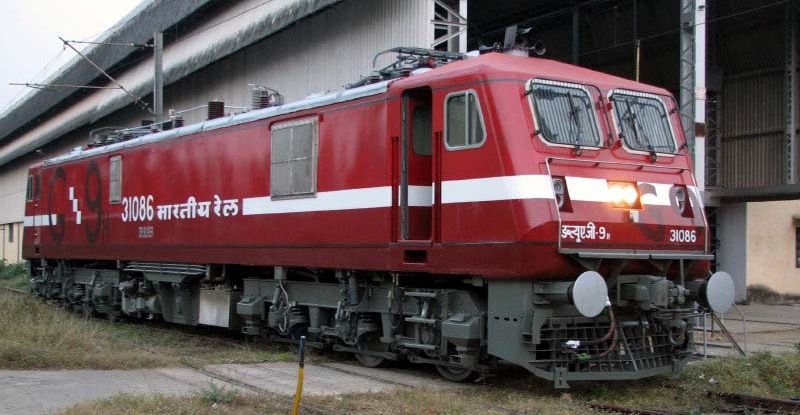
Dr.Silver’s unique livery was designed by Mr. Samit Roychoudhury, veteran IRFCA member, catrographer and author the super-awesome “The Great Indian Railway Atlas“, a must buy for any Indian rail traveler (and others too)! Picture courtesy and copyright: Samit and IRFCA.
WAG 10
- “Converted” rebuild of 2xWDG3A + 2xWDM4.
- Period of production: 2018
- Number built: 2
- Top rated power: 10000hp
- Wheel Arrangement: Co-Co-Co+Co-Co-Co
- Very high starting Tractive effort (43x2t)
- Axle Load: 21.5t
The WAG10 is an experimental class of locomotive that was born out of CLWs and BLWs experimentations. In 2017 the Indian Government took a decision to completely electrify all railway lines. This created a situation where there would soon be an immediate surplus of diesel locomotives and a shortage of electric locomotives. There was no way the two locomotive builders were going to be able to meet the demand for new WAG9s. So, BNW embarked on an ambitious plan to convert diesel locomotives to electric. The plan was to produce high-powered locomotives to run on the DFCs and would complement Alstom’s upcoming Prima locomotives.
The class was first named WAGC3 (C for Converted), but was later renamed to WAG10. Two locomotives are produced and in service, #10001 and #10002. Technically, they are not really diesel locomotives “converted” to electric but rebuilds created by combining the parts of four separate locomotives, two electric and two diesel, to create one high-powered articulated electric locomotive that combines two units into one. Both these locos were hand-built and hence they are very unique.
- For #10001 the body frame, the driving cabs and the bogies come from WDG3As #14593 and #14786. The body shells (sides) and electrical equipment come from WAM4s #21382 and #21386. It looks weird with two ALCO short hoods at either ends.
- For #10002 the bogies came from WDG3As #14561 and #14791 while the cabs were new one in the WAG9 design. One of the body shells and electricals came from WAM4 #21332. It looks much better with the WAG9 driving cabs.
It is not clear if more of this class will be produced.
WAG 11
To be added.
WAG 12
- Among the world’s most powerful freight locomotives
- India’s first twin section articulated locomotive
- Based on the Alstom Prima II built by Alstom in Bihar
- Wheel Arrangement: Bo-Bo+Bo-Bo
- Period of Production: 2018+
- Number Produced: 128 (800 will be made)
- Power Rating: 12000 hp
- Top Speed: 120 kph
- Weight: 200t; Tractive Effort: 80t; Axle Load: 25t
In 2006, the Government of India approved the Dedicated Freight Corridor (DFC) project and set up the DFCIL to build it. In this grand scheme the present locomotives, even the WAG9Hi wouldn’t be enough to cut it. Hence, it was decided to procure new, super-powerful locomotives for dedicated operations on the two DFCs. The WAG12 would be the result of a global tender, where the awardee would build the locomotive at a new factory at Madhepura in Bihar under a joint venture with 26% stake by the Indian Railways and 74% by the bidder. The tender was called in 2008 and it wasn’t until 2015 that the contract was awarded to Alstom. 800 locos would be built at the facility, out of which the first five would be assembled from fully imported kits, while the remaining would be built at Madhepura and rolled out in a phased manner. Alstom announced that the new locomotive would be based on its highly successful Prima II model. Alstom calls it the Prima T8. This was the first time in 20 years that Indian Railways procured new locomotives.
The WAG12 is, as is specified by RDSO, a “1676 mm gauge 9000 kW 8-axle IGBT-based 3 phase drive electric freight locomotive“. The WAG12 is an articulated twin-section locomotive putting out 12000 hp, which means that it is two separate 6000 hp units coupled together. Each unit has a forward driving cab at one end and a vestibule at the other and two Bo-Bo (twin axle) bogies, hence eight axles and 16 wheels in total. The units will always operate together as one single locomotive with one road number. The WAG12 will be only the second locomotive type of the Indian Railways using Bo-Bo configuration after the WAP5. All other loco bogies in India have three axles. The WAG12 made its first appearance on social media on 27 February 2018, a date as fitting as it ever could be. It was unlike anything on Indian rails and eclipsed all locomotives just like WDP4s and the WAG9 did earlier.
The twin sections of the WAG12 is the result of its design specifications. All that equipment to produce 9 mega watts (12000 hp) of power will not into the body shell of a standard locomotive. The traction motors necessary to produce such torque would not even fit onto standard axles, so more axles are needed for optimum load distribution and pulling power. All this made the WAG12 to be around 38 metres long. Now, no railway vehicle on Indian Railways may be longer than 25 metres, else they won’t be able to negotiate turnouts. The solution was to add a vestibule at the middle, making it a twin section locomotive. It is only like a WAG9 that is twice its length and can bend at the middle.
The massive specifications of the WAG12 dwarf even the WAG9 (double the tractive effort) and made WAG7s look like shunting locos. The WAG12 can haul 7000 tonnes of load at a gradient of 1:200 in dry conditions at 75 kph. It is engineered to withstand everything from 50 degree sandblasts of the Rajasthan deserts to the dry, salt-laden winds of Gujarat, the ultra-humid plains of UP and Bengal and the torrential monsoons of Maharashtra. It will be as “ultramodern” as any other locomotive in the world, with high-tech cutting edge systems including GPS and GPRS-based remote diagnostics, tracking and systems monitoring, wireless control of MU’ed locomotives, cruise control, autopilot, incident recorder or a “black box”, etc. Crew comforts include a fully air-conditioned cabin as a default feature, fully digital equipment (glass cockpit), advanced seating ergonomics, a pantry and a toilet.
And thus started the age of the Prima.
More details about these locos will be published here as they are available.
Thus we have reached the end of the long evolutionary line of Indian Railways’ most important, prolific and extraordinary class of locomotives whose hard work is the “thicker” of the blood that is the lifeline of the nation. As India’s freight needs only keep on increasing there will be many more WAGs to come for sure, because even the WAG9 is relatively underpowered by international standards where freight locomotives are regularly rated at around 10000 hp! Let us hope that we will soon see such a locomotive or a (800 of them) in India!
Up next, we will check out the most visible stars of the Indian Railways, the WAP class!
P.S. Due to my limited knowledge, there might be mistakes in this post. Everyone is welcome to suggest corrections! We don’t want the world to learn wrong things, do we now? 🙂
More Chapters on Indian Locomotives
Locomotives of the Indian Railways | Locomotives Terminologies and Design
How Locomotives are Classified | How Electric and Diesel Locomotives Work
DIESELS: The WDM Series (ALCOs) | The WDP and WDG Series (ALCOs and EMDs)
ELECTRICS: DC and AC/DC Locos | The WAM Series (AC mixed) | The WAG Series (AC Goods)

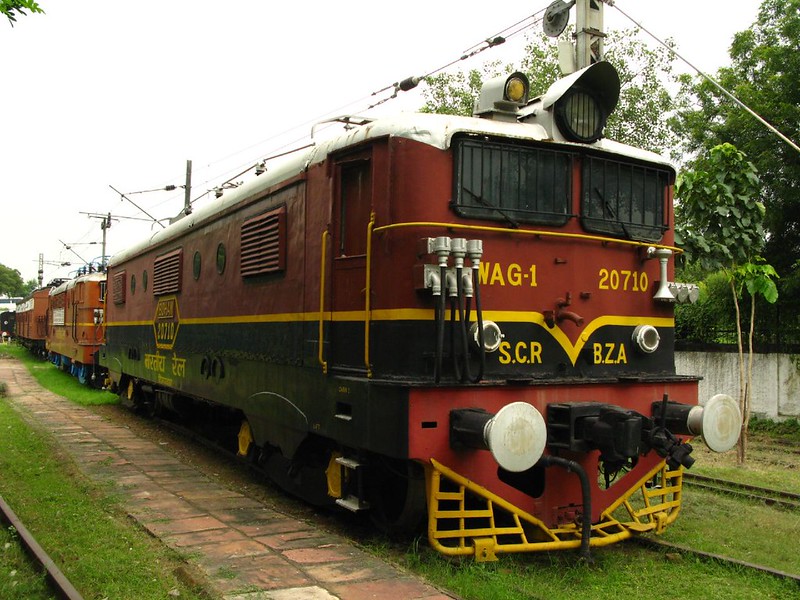

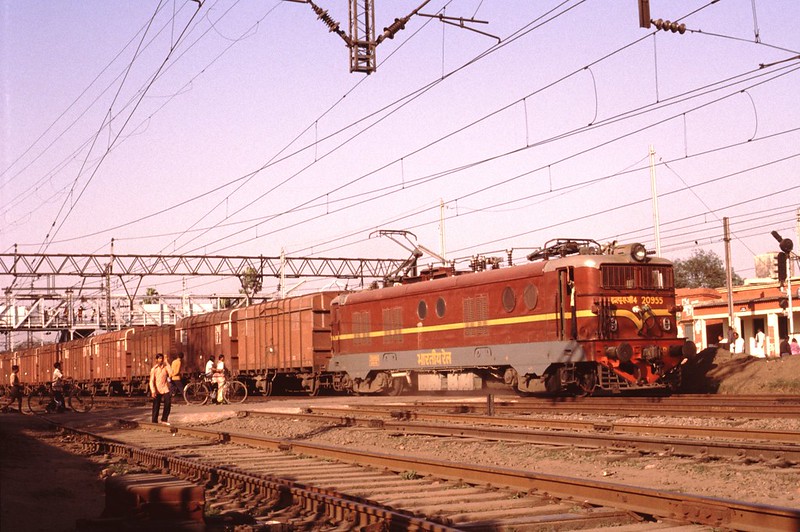
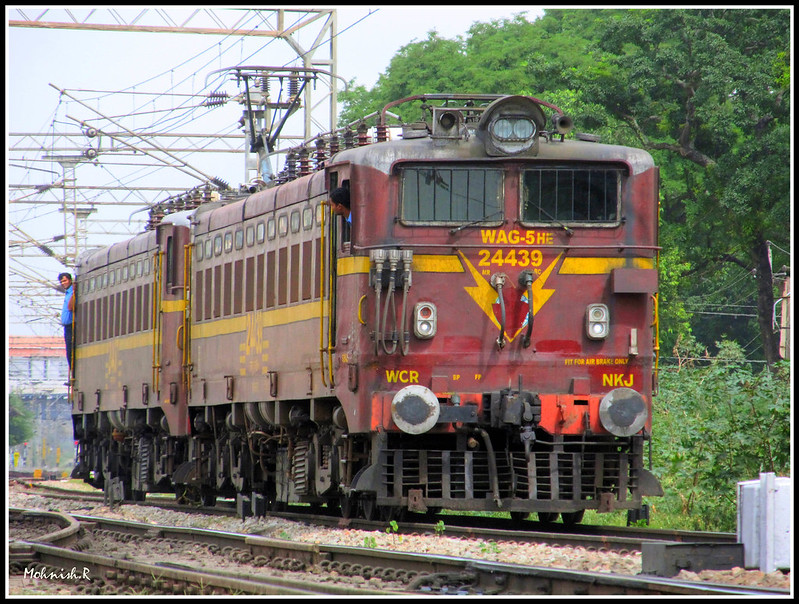


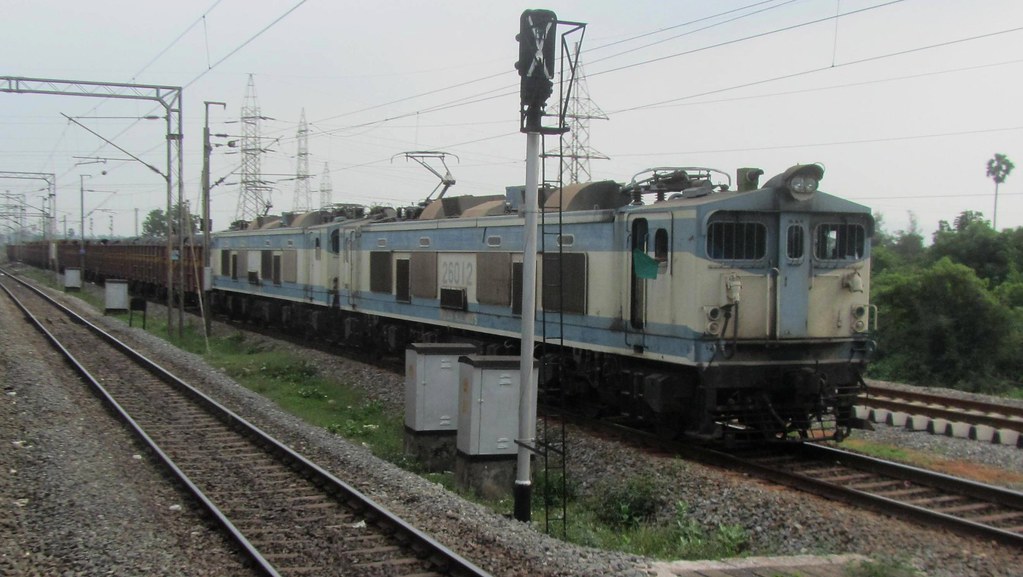
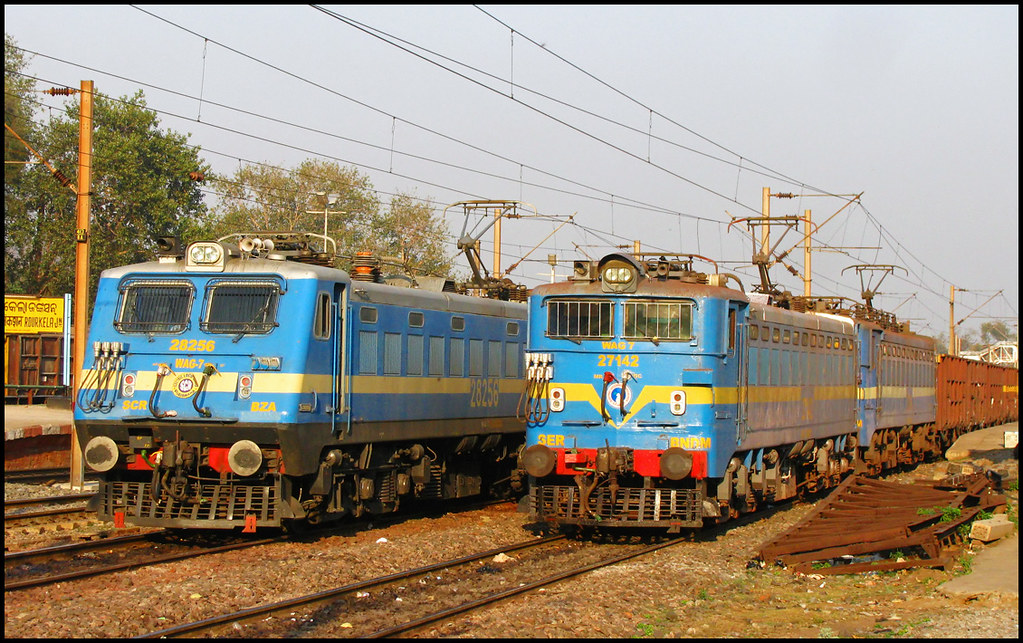
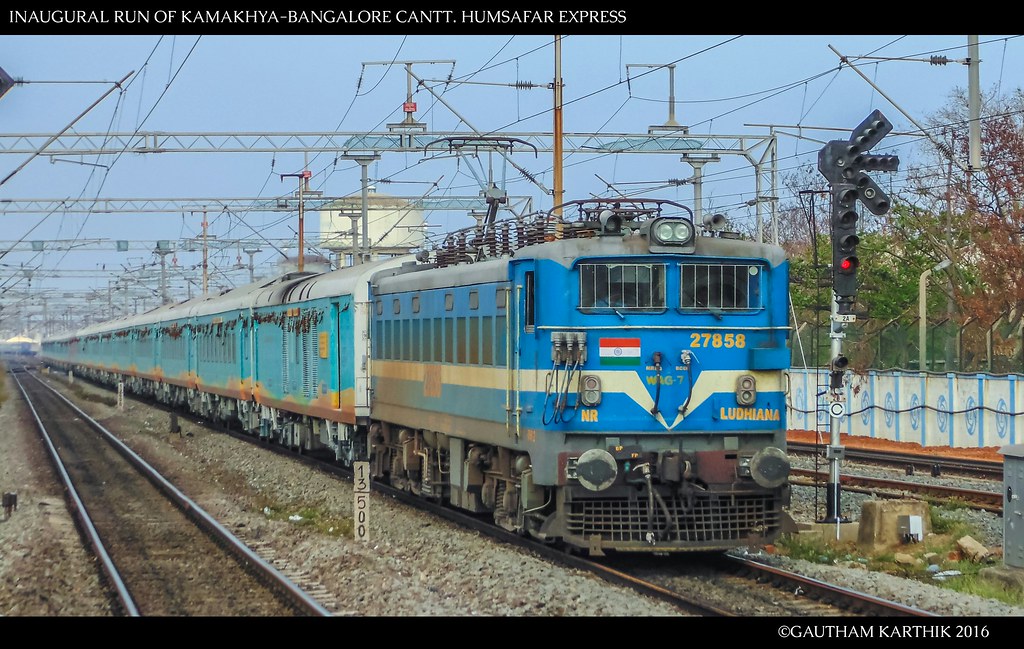
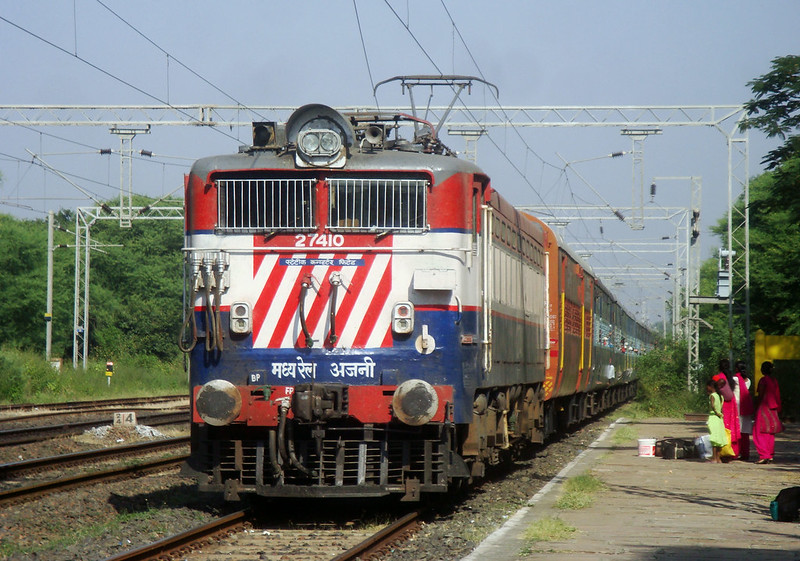

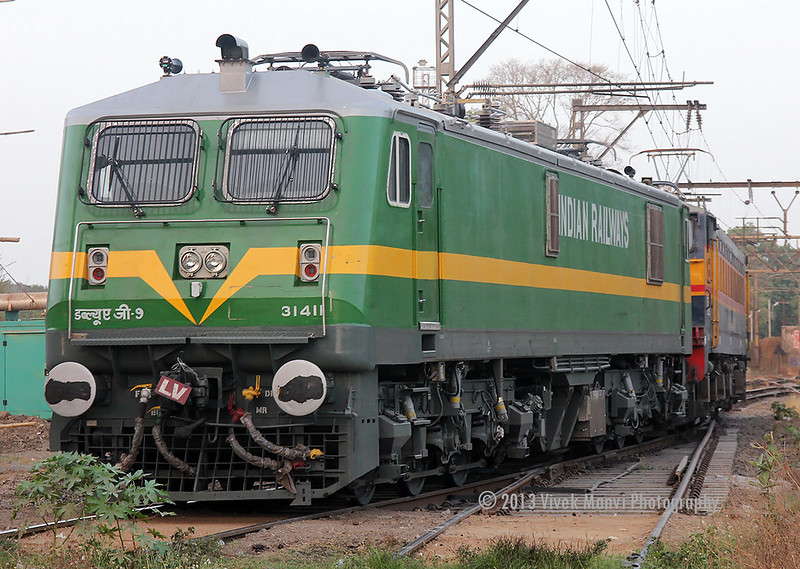



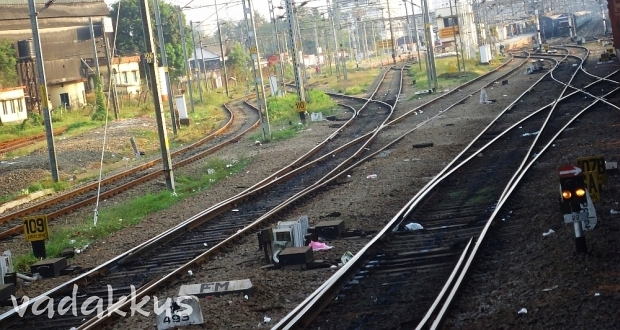

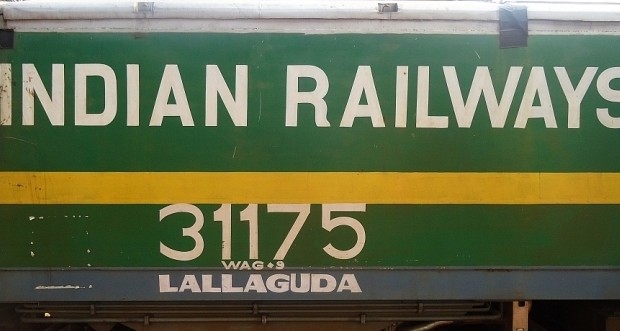
@the editor…..
“WAG12 – The world’s most powerful freight locomotive.”
Sorry about that – but this is as wrong as it can be. The problem is: WAG12 is a multiple unit. This leads one or the other to the – in my opinion – wrong view, one must consider and judge the sections individually, unit-wise …….
To my knowledge, both sections of WAG12 can be operated on their own, however, in terms of operational control, the multi-unit is seen as ONE locomotive, therefore, incidentally, the same number for both halves.
Another example: The Swiss SBB Re 10/10 actually consists of two independent locomotives, a four- and a six-axle locomotive, which can drive independently without further ado. But they are seen – in the operational sense – as ONE loco. So it doesnt make sense to consider such combinations as individual locomotives (as some like to do), if the operational control does not do that.
WAG12 is neither the world’s most powerful locomotive nor the most powerful electric locomotive – and even the single unit is certainly not the strongest unit of neither a multi-unit locomotive nor a single-frame locomotive.
The most powerful locomotive to date is the russian Novocherkassk 4E5K, an electric locomotive of the RZD consisting of four permanently coupled units with a total of almost 18,000 hp.
Then there would be to call the Swedish IORE II: 2 units, 14500 hp.
Next is the chinese Datong HXD1 or 2, double units with 12600 hp.
Again a russian beauty: Novocherkassk VL85 – 2 units, 12500 hp.
Switzerland: SBB Re10 / 10, a fixed coupled combination of Re 4/4 and Re 6/6, about 12500 hp
An example of an internal combustion engine locomotive for freight: The russian Sinara GT1h-002, 2 units, 13000 hp. This is a really special machine – she runs on LNG and has a gas turbine as prime mover………
I am pretty sure some WAG2s were homed in Bhusaval in the 1980s and served the Igatpuri-Bhusaval section which was powered by 25 KV AC and at that time surrounded by unnelectrified or DC powered sections.
Where is WAG 10 and 11
very nicely written… one thing to know. if both WAG6A are still alive (Retired) are they kept for display or where are they? any idea about their whereabouts?